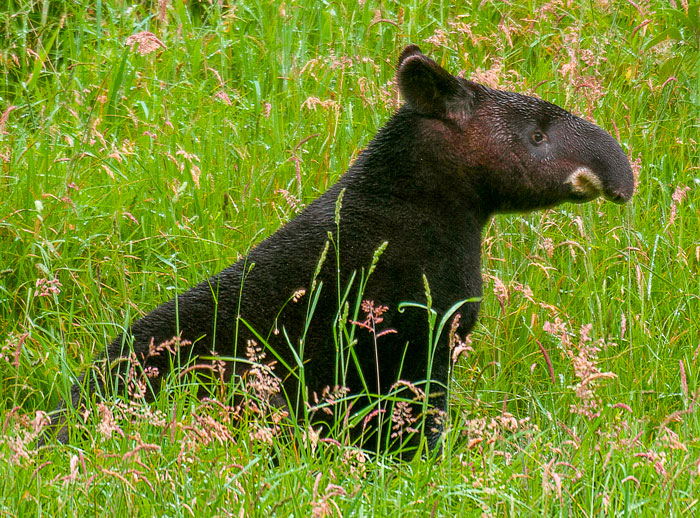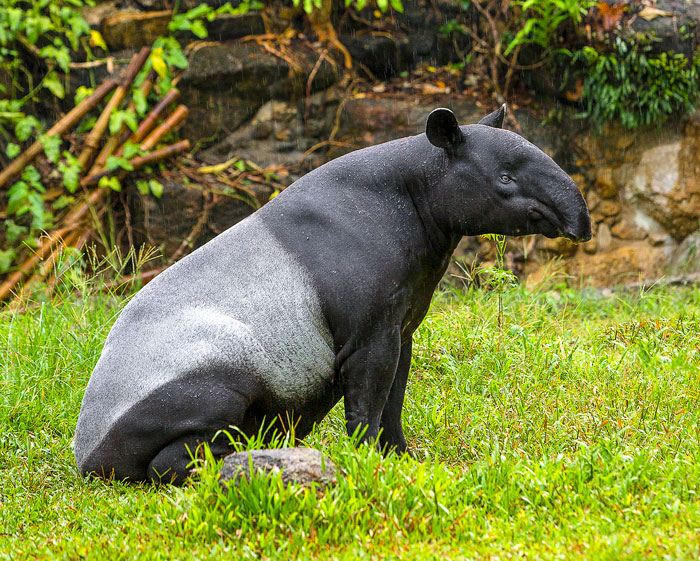The tapir

A Malayan tapir (Tapirus indicus) that escaped from the San Diego Zoo was recaptured a few days later when the Zoo “received a call from a woman shrieking into the phone that a ‘rhinoceros’ was loose in the sewer.”1
The misidentification may be understandable, given many people have never seen a tapir (pronounced like ‘appear’, or less commonly, like ‘taper’ or even ‘tarp-ear’).
Tapirs have been mistaken for hippos, pigs, anteaters, even elephants, as well as rhinos. They have been described as being a “hodge-podge” of varying animal characteristics.2,3 In Thailand, the word for tapir is p’som-sett, meaning ‘mixed scraps’, a kitchen phrase referring to the tapir looking like a blend of parts left over from the creating of other animals.2,3,4 This nocturnal (night-active) mostly forest-floor dweller looks a bit like an anteater but has a sturdy pig- or hippo-like body (weighing up to 400 kg (880 lb)), and can be as tall as a donkey. A most distinctive feature of this herbivore is that the tapir’s nose and upper lip comprise a trunk, which is flexible like an elephant’s (but shorter).
One species of tapir lives in various Southeast Asian countries.5 Three other species live in Central and South America. They inhabit rainforests, grasslands and even rocky mountain areas, so long as there is a good source of water.
Much of what we know about tapirs has come from studying animals in captivity. E.g., their life-spans can extend beyond 40 years. Though mostly docile, zoo tapirs have sometimes savagely bitten people who got too close.
‘Creation’: traditional, self-evident, logical

The Thai p’som-sett creation anecdote of the tapir’s creation might surprise some people since Thailand’s majority religion is Buddhism, which does not teach of a creator.6 But p’som-sett is symptomatic of the traditional ‘default’ view, all around the world, that everything around us was created.7 Studies of young children in various countries reveal they see nature as logically having been designed, not by people but by a Creator God—even children who have never received any such instruction.8
Such findings dismay leading atheists, who have tried to argue that belief in God is propagated through religious ‘indoctrination’. Meanwhile they have aggressively sought to indoctrinate others, especially children, in secular humanism. Central to their strategy is promoting the teaching of evolution,9 with its attendant implications—e.g. that some species are less ‘advanced’, including the tapir: “Tapirs are the most primitive large mammals in the world.”2
But is evolution really the ‘rational’ explanation for origins?
Forced ‘relatives’

According to evolution, all living things are related (cf. biblical creation, with the different kinds of creatures being created separately, to reproduce “after their kind”). Evolutionists have nominated the rhinoceros and the horse as being the tapir’s closest relatives. The three occupy the order Perissodactyla, which includes all hoofed animals having an odd number of toes on their hind feet.
But the tapirs’ distinctive features, so starkly differing from rhinos and horses, cannot be so readily accommodated by ‘evolutionspeak’. E.g. the prehensile (gripping) tapir trunk, to be fully functional, needs to be appropriately anchored to a matching skull. Thus, the shape of tapir skulls, and the associated muscles and nerves, are truly unique in comparison to horses and rhinos. According to evolutionists, this had to involve “wholesale transformation of the narial [nostril] apparatus and facial architecture” relative to other Perissodactyla, a “dramatic reorganization of virtually the entire head.”10
Furthermore, as anatomical knowledge increases, long-held evolutionary assumptions are being shown to be false. One example is the belief that a feature of the tapir’s nasal cavity called the ‘meatal diverticulum’ corresponds to the ‘false nostril’ of horses in its evolutionary derivation (is ‘homologous’). But it turns out to be so dissimilar as to rule this out.10
Missing links
A major challenge for evolutionists is how the Perissodactyla as a group are evolutionarily related to other orders of mammals. Indeed the problem of precisely how and where the perissodactyls (rhinos, horses, tapirs) are supposed to have evolved has been described as “one of the great conundrums of mammalian evolution”.11 From an evolutionary viewpoint, their fossils “appeared abruptly at the beginning of the Eocene [said to be 55 million years ago according to evolutionary thinking] across the Holarctic continents [North America, northern Eurasia, and North Africa], with little indication of their source.”11
Tapirs are ‘living fossils’

Tapir fossils have been found in rocks of every continent except Antarctica and they’re all (surprise, surprise) clearly tapirs. In the words of evolutionary paleontologists, “For tapirs, all the evolutionary action was over after the Eocene.”12 This means tapirs alive today are evolutionarily known as “living fossils”3,13,14,—so why no evolution during all those supposed millions of years? The following comment by an evolutionist on this stasis (tapirs staying the same) shows how ‘evolution’ can be conveniently and bizarrely defined to mean both incredible (Designer-free) change or none whatsoever: “[I]f we are going to understand evolution at all, we must learn to appreciate an apparent lack of change as well as spectacular transformations.”12
In reality, tapirs have always been tapirs, reproducing “after their kind” (with ‘kind’ equating to the taxonomic family Tapiridae) since Day 6 of Creation Week only about 6,000 years ago, just as God intended them to do (Genesis 1:24–25). And the tapir-fossil-bearing rock strata purported to be millions of years old are instead a legacy of Noah’s Flood (Genesis 6–9) about 4,500 years ago.
‘Out-of-place’ puzzle
With three of the four living tapir species from Central and South America, evolutionists have quipped that this makes the single tapir species of Southeast Asia “seem out of place”, i.e. the Malayan tapir is “a strange outlier.”12 The 19th century biologist Alfred Russel Wallace, credited in the 1850s as having independently formulated evolutionary ideas of natural selection at the same time as Charles Darwin, wrote of the tapir in his 1889 book Darwinism: “These curious animals form one of the puzzles of geographical distribution”.12 He speculated that local extinction of tapirs and competition from other mammals could account for “the anomaly of allied forms occurring only in remote and widely separated areas.”12
Wallace may have been partly right. Compare this to the creationist view that post-Flood tapirs multiplied and spread out from the Ark’s landing site “on the mountains of Ararat” (Genesis 8:4), with further outward migration and local extinction leaving today’s tapir ‘remnant’ populations in Central/South America and Southeast Asia. But where do evolutionists put their ‘centre of evolution’ of the tapir? Some have said North America,12 others point to India,11 but it seems there’s a general wariness of nominating anywhere in or near the Middle East—not wanting to give credence to the Bible’s account of history, perhaps? Yet that eyewitness account fits the available evidence.
Not ‘primitive’, or ‘leftovers’, but a masterpiece!

When one considers just some of the amazing things that tapirs can do, and their (design) features, the evolutionary tag ‘primitive’ seems both unfair and inaccurate:
Their large, solid bodies enable them to barrel along unconcernedly through thick vegetation as they forage for food;
They are excellent swimmers, and not just at the surface—using their ‘snorkel’ they also dive down to eat vegetation at the bottom;
Tapir reproductive anatomy is uniquely distinctive, with male and female being perfectly matched to each other, and because of special flaps that function as seals to keep water out, tapirs can mate in swamps just as well as on dry land;15
Even in rainy, slippery conditions, tapirs can navigate sure-footedly up steep, rocky slopes.4
No wonder one evolution-believing commentator described tapirs as being “a masterpiece”.3
Neither ‘primitive’ nor a ‘hodge-podge of leftovers’, tapirs were rather designed to live as and where they do; and the things they do, they do well!
References and notes
- Tapir; animals.sandiegozoo.org, acc. 5 Feb 2019. Return to text.
- Bradford, A., Facts about tapirs; livescience.com, 27 Jun 2016. Return to text.
- Heimbuch, J., 6 surprising facts about tapirs—The tapir may look like a visual hodgepodge of other species, but this ancient creature is a masterpiece; mnn.com, 13 Mar 2018. Return to text.
- Webster, R., Elephant-zebra? Nah, it’s a Malayan tapir; pawmanefin.com, acc. 6 Mar 2019. Return to text.
- Indonesia, Malaysia, Burma, and Thailand. Return to text.
- Grigg, R., The Dalai Lama, the Templeton Prize, and Buddhism, 20 Nov 2012. Return to text.
- Smith, C., World creation stories, 6 Jan 2011. Return to text.
- See Catchpoole, D., Children see the world as ‘designed’! 16 Jul 2009. Return to text.
- See: Armstrong, W. and Sarfati, J., The ‘Indoctrinator’, 2001. Return to text.
- Witmer, L., and 2 others, The proboscis of tapirs (Mammalia: Perissodactyla): a case study in novel narial anatomy, Journal of Zoology 249(3):249–267, 1999. Return to text.
- Rose, K., and 8 others, Early Eocene fossils suggest that the mammalian order Perissodactyla originated in India, Nature Communications 5:5570, 2014. Return to text.
- Switek, B., In life’s race, tapirs took a slow and steady pace; wired.com, 27 Apr 2011. Return to text.
- Brenna, L., 10 things you may not know about tapirs; lifegate.com, 26 Feb 2015. Return to text.
- Tapir Specialist Group; tapirs.org, acc. 12 Feb 2019. Return to text.
- Edmonds, P., Tapirs are surprisingly well-endowed; nationalgeographic.com, Oct 2016. Return to text.




Readers’ comments
Comments are automatically closed 14 days after publication.